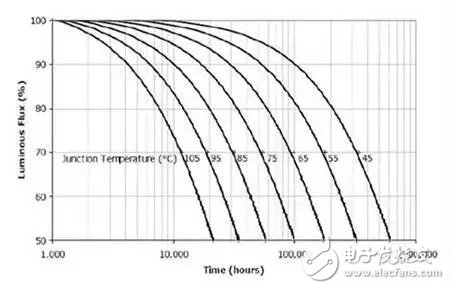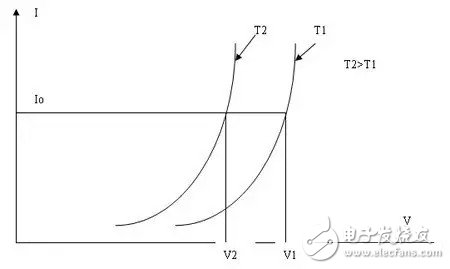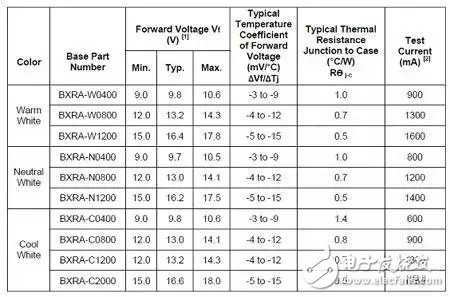Light decay is a common problem in the LED industry. It often makes people feel a headache. What is the relationship between LED Lighting and LED lamp life? How can we solve the problem of light decay? Finally found a better way, is to look at the picture to speak.
Below is the light decay curve:

It can be seen from the figure that the light decay of the LED is related to its junction temperature. The so-called junction temperature is the temperature of the semiconductor PN junction. The higher the junction temperature, the earlier the light decay, that is, the shorter the lifetime. As can be seen from the figure, if the junction temperature is 105 degrees, the lifetime of brightness reduction to 70% is only 10,000 hours, there are 20,000 hours at 95 degrees, and the junction temperature is reduced to 75 degrees, and the life expectancy is 50,000 hours. It can be extended to 90,000 hours at 65 degrees. So the key to extending life is to lower the junction temperature, but these data are only suitable for Cree's LEDs, not for other companies' LEDs.
How to extend the life of LEDs
Therefore, when we buy LED lamps (all of which do not specifically refer to LED spotlights), we must look at its heat dissipation design.
It can be concluded from the figure that the key to extending its life is to lower its junction temperature. The key to lowering the junction temperature is to have a good heat sink that can dissipate the heat generated by the LED in time.
Here we are not going to discuss how to design a heat sink, but to discuss which heat sink has a relatively good heat dissipation effect. In fact, this is a junction temperature measurement problem. If we can measure the junction temperature that any heat sink can achieve, we can not only compare the heat dissipation effects of various heat sinks, but also know that after using this heat sink. The LED life that can be achieved.
How to measure junction temperature
The junction temperature appears to be a temperature measurement problem, but the junction temperature to be measured is inside the LED. It is not possible to put a thermometer or thermocouple into the PN junction to measure its temperature. Of course, its case temperature can still be measured with a thermocouple, and then based on the given thermal resistance Rjc (junction to the case), its junction temperature can be derived.
But after installing the heatsink, the problem became complicated again. Since the LED is usually soldered to an aluminum substrate, and the aluminum substrate is mounted on the heat sink, if only the temperature of the heat sink case can be measured, it is necessary to know the value of many thermal resistances in order to calculate the junction temperature. Including Rjc (junction to case), Rcm (shell to aluminum substrate, which should also include the thermal resistance of the film printed version), Rms (aluminum substrate to heat sink), Rsa (heat sink to air), as long as there is a Inaccurate data can affect the accuracy of the test.
The figure below shows a schematic diagram of the individual thermal resistance of the LED to the heat sink. It incorporates a lot of thermal resistance, making its accuracy more limited. That is to say, it is even worse to estimate the junction temperature from the measured surface temperature of the radiator.

Schematic diagram of the thermal resistance of the LED to the heat sink
Fortunately, there is a way to measure temperature indirectly, that is, to measure the voltage. So which voltage is the junction temperature related to? What is the relationship like? We must first start with the volt-ampere characteristics of LEDs.
Temperature coefficient of volt-ampere characteristics of LED
We know that an LED is a semiconductor diode that has the same volt-ampere characteristics as all diodes. Like all semiconductor diodes, this volt-ampere characteristic has a temperature characteristic. Its characteristic is that when the temperature rises, the volt-ampere characteristic shifts to the left. The temperature characteristics of the volt-ampere characteristics of the LED are plotted.

Assume that the LED is powered by Io constant current. When the junction temperature is T1, the voltage is V1, and when the junction temperature rises to T2, the entire volt-ampere characteristic shifts to the left, the current Io does not change, and the voltage becomes V2. The two voltage differences are removed by temperature and the temperature coefficient is obtained, expressed in mV/oC. For ordinary silicon diodes, this temperature coefficient is approximately -2mV/oC. But most of the LEDs are not made of silicon, so its temperature coefficient has to be measured separately. Fortunately, most of the LED manufacturers' data sheets give their temperature coefficients. For example, Cree's XLamp7090XR-E high power LED has a temperature coefficient of -4mV/oC. It is 2 times larger than ordinary silicon diodes. As for the US Puri's array of LEDs (BXRA), more detailed data is given.

However, the scope of the data they gave was too large to be lost. In any case, as long as the temperature coefficient of the LED is known, it is easy to estimate the junction temperature of the LED from the forward voltage of the measuring LED.
How to predict the life of this luminaire
Estimating the life from the junction temperature seems to be very simple. Just look up the curve in Figure 1 and you can see that the life of the LED is 20,000 hours corresponding to the lifetime at 95 ° junction temperature. However, this method has certain credibility for indoor LED lamps. If applied to outdoor LED lamps, especially high-power LED street lamps, there are still many uncertain factors.
The biggest problem is that the heat dissipation efficiency of the LED street light's heat sink decreases over time. This is due to the accumulation of dust and guanine, which reduces the heat dissipation efficiency. Also, because there is a strong ultraviolet light outside, it will also reduce the life of the LED. Ultraviolet light is mainly used to age the encapsulated epoxy resin. If silica gel is used, it can be improved. Ultraviolet light also has some bad effects on the aging of the phosphor, but it is not very serious.
However, this method is relatively effective in comparing the heat dissipation effects of the two heat sinks. It is obvious that the heat sink with a small left-shifting volt-ampere characteristic has a better heat dissipation effect. In addition, there is still a certain degree of accuracy in predicting the life of indoor LED lamps.
SHENZHEN CHONDEKUAI TECHNOLOGY CO.LTD , https://www.szsiheyi.com